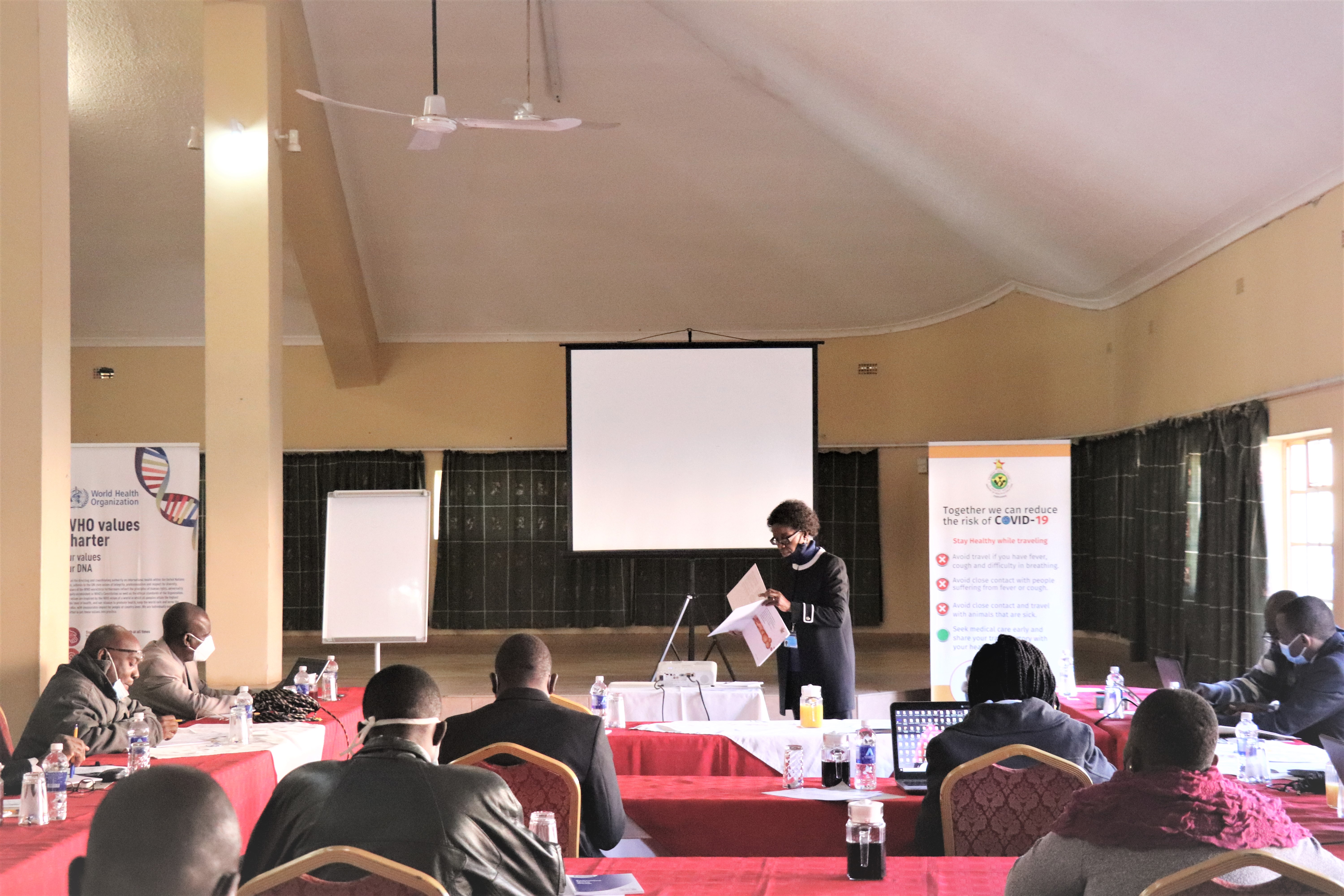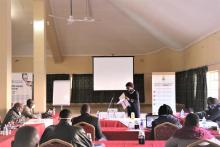MoHCC enriches Zimbabwe’s quarantine staff’s capacity to manage individuals in quarantine facilities

By Tatenda Chimbwanda
Mazowe, Zimbabwe- Twenty-four participants from Zimbabwe’s 10 provinces recently underwent training funded by WHO at a workshop aimed at addressing gaps identified by the Government of Zimbabwe (GoZ) in the Quarantine Centre Assessment Report. Titled “Training of Trainers on the Integrated Management of Individuals in Quarantine Facilities for the prevention of COVID-19 in Zimbabwe”, the two-day training between June 18 and 19 at Mazowe Hotel, just outside Harare was attended by participants comprising three per province frontline staff at quarantine centres across Zimbabwe. Representatives from various GoZ Ministries namely; Ministry of Health and Child Care, Home Affairs Foreign Affairs, Labour and Social Welfare attended the workshop. As well as Centre for Disease Control and Prevention (CDC) Africa, UN Women, WHO, International Organisaion for Migration (IOM) and United Nations Population Fund (UNFPA).
In her opening remarks Chief Coordinator of COVID-19 Task Force in Zimbabwe, Dr Agnes Mahomva, expressed gratitude to the Ministry of Labour and Social Welfare for identifying quarantine centres across Zimbabwe. However, she said, identifying these facilities is not good enough on its own, there was need to manage them in an efficient and effective way with the growing numbers of returnees in the centres.
“As the Government of Zimbabwe let’s be passionate and keep working together and better coordination amongst our different ministries. I am happy to see all the three main ministries; Ministry of Health and Child Care (MoHCC), Labour and Social Welfare and Security Forces present today. It is so important we have come together to train as we cannot continue working in isolation like we did before,” said Dr Mahomva.
The training started by outlining gaps identified in the GoZ Quarantine Centre Assessment Report conducted between May 17-21, 2020 with financial and technical support from the IOM and WHO. The assessment concluded that most of the quarantine centres were not being managed in line with expected standards. For instance, gaps were noted in the overall management of the quarantine centres and most of the staff involved in managing them had not received any formal training or orientation prior to taking on their responsibilities. In order to ensure that the quarantine centres contribute to prevention of importation of COVID-19 and containment of ongoing transmission in Zimbabwe, several interventions were recommended. These include the distribution of the integrated guidelines for management of individuals in institutional quarantine and training in screening, testing and timely identification of COVID-19 and referral mechanisms.
Provision and/or referral for risk communication, health promotion, psychosocial and other medical services and conflict management, and prevention of sexual exploitation and abuse (PSEA), psychologic first aid and sexual gender based violence (SGBV) referrals, including the survivor centre approach were discussed during the training. One of the training facilitators, Dr Tafara Moga from the MoHCC emphasised why all the quarantine staff should be guided by the Integrated Guidelines for the Management of Individuals in Institutional Quarantine.
“These quarantine guidelines are set to help minimise the risk of COVID-19 transmission and help us move away from the growing public perception of quarantine centres being epicentres of the virus. It is important to carry that from this training,” added Dr Moga.
Furthermore, the trainees were urged to treat everyone in the centres with caution, as if they are infected. They were also strongly recommended to educate the people in the quarantine centres and exercise the greatest level of professionalism. Masvingo Province Social Welfare Officer and coordinator of all the quarantine centres, Chengetai Nyamunga, said the training was an eye opener.
“I am happy l attended this training as the Social Welfare Officer and coordinator of all the quarantine centres in the whole of Masvingo Province. Before this training we were extremely clueless on how to run quarantine centres in Masvingo. It was more like guess work and this training has provided me with standard guidelines to follow,” explained Nyamunga.
Ignitious Mwanza from Mashonaland West Province explained how the training has helped him clarify the different roles each stakeholder should be playing in the quarantine centres.
“We had a major issue with security forces not having Personal Protective Equipment (PPE) including the returnees. It wasn’t clear who should provide this PPE, the training has really clarified this for me through outlining the roles of various ministries in quarantine centres,” Mwanza said.
Manicaland Province Provincial Medical Director (PMD) Simon Nyadundu, said the huge number of returnees in their province was confusing. “Manicaland province has the second highest number of returnees in Zimbabwe and there was a lot of confusion.
“As the PMD of Manicaland province this training has really provided clarity through the guidelines on how different stakeholders should be conducting their duties and it’s something l will take back to my province as l conduct my provincial trainings,” Nyadundu noted.
The acting Chief Director Preventive Services of MoHCC Cremence Tshuma, concluding remarks captured the main issues of discussions raised during the training and action points going forward.
“It is clear we have all been doing our own things, therefore, each province should develop their own Standard Operating Procedures (SOPs), which are context specific and guided by the Quarantine Centre Guidelines.” He said given that most quarantine centres were in schools which are about to open, provinces should look for new quarantine centre sites.
The new quarantine sites, he added, should be guided by the quarantine guidelines. The facilities should also meet the infrastructure requirements.
“Where these requirements are not met, they should come up with a budget and reach out to different partners for support with renovations. “And most importantly, positive asymptotic patients should be placed in hospitals as it will hinder continuation of other health services.”
WHO also availed technical support of all the presentations to ensure adherence to WHO guidelines on COVID-19 Infection Prevention and Control (IPC) measures. Trainees such as Nyamunga, Mwanza and Nyadundu (mentioned above) are now equipped with knowledge and skills to better manage the quarantine centres in line with the standards and provisions as laid down in the integrated guidelines for management of individuals in institutional quarantine in Zimbabwe.
The trained trainers are expected to immediately cascade the new knowledge in their respective provinces. Quarantine staff capacity building is one of the main outputs of Pillar 4 (Point of Entry) under Zimbabwe’s COVID-19 operational plan. The Point of Entry (POE) pillar main objective is to detect all COVID-19 cases (Entry and Exit screening) and initiate contact tracing. WHO continues to work closely with other POE pillar members; IOM, UN Women, UNICEF and UNFPA to support GoZ implement quarantine recommendations.
Communications Officer
Tel: + 263 914 31408
Email: juliasw [at] who.int (juliasw[at]who[dot]int)








